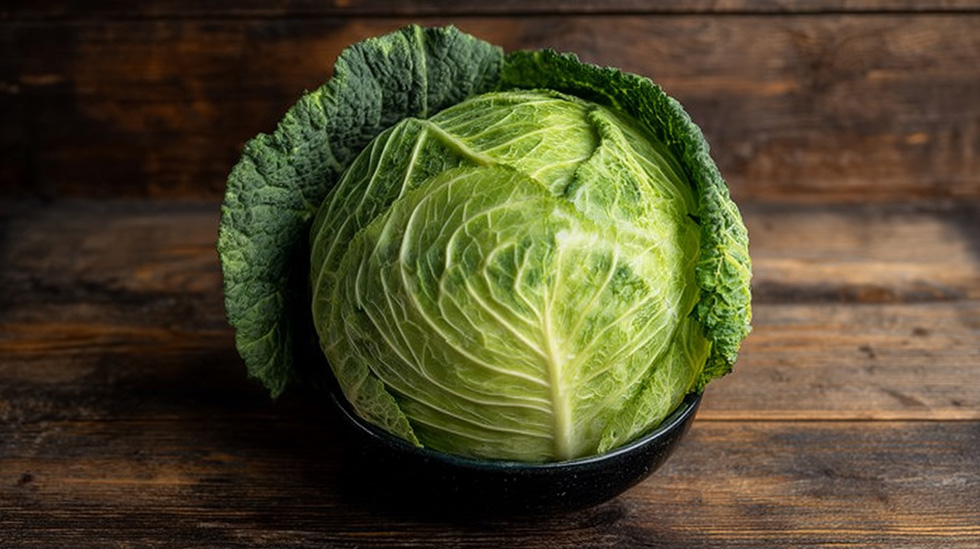Cabbage – The big green ball without which life is not life 🥬
Cabbage, also known simply as cabbage or “cabbage” (in peasant parlance), belongs to the cruciferous family. Latin name: Brassica oleracea var. capitata . It was already known in antiquity: the Greeks and Romans cultivated it, and Hippocrates even recommended it as a medicine. In our country, it has been a mainstay of the cuisine for centuries, from sauerkraut to casseroles, and is known and loved by everyone.

It originated in the Mediterranean and has become one of the most popular vegetables in Europe and even the world.
How important is it in the kitchen?
Rating: 5/5
Cabbage is simply unmissable in Hungarian cuisine. Just think of stuffed cabbage, Székely cabbage, or Frankfurt soup – all of them are unimaginable without it. In other parts of Europe, you’ll often find it pickled, braised, fried or even raw as a salad. Cheap, filling, versatile – a real kitchen staple!
Which part can we eat?
The edible part of the cabbage is the “ball” of decayed leaves itself. These leaves can be greenish-white, yellowish or even purple, depending on the variety. The inner, tender leaves are particularly sweet and tender, and are excellent for salads. The outer leaves are often thicker and tougher, but are great for cooking and braising.
The torsos, or thick middle stalk, is also edible, but harder and more fibrous – many prefer to throw it away or use it only for cooking. The root system is not edible and, as it may be contaminated with soil, special care should be taken to clean it.
Why is it healthy?
Cabbage is a vitamin bomb:
- High in vitamin C – especially in the raw and pickled versions
- Rich in vitamin K, folic acid, fibre
- Beneficial for digestion
- Contains antioxidants that help protect cells
- According to traditional folk medicine, it is an anti-inflammatory, blood purifier, and has even been used as a poultice for headaches
Where does cabbage come from?
The cabbage season runs from June to the end of November, although storage varieties are available throughout the winter. Poland, Germany and the Netherlands are among the largest producers in Europe. It also grows well in Hungary – especially in the southern Great Plain and parts of the Transdanubian region. It is mainly grown outdoors, but early varieties are also sometimes grown in foil.
You can find fresh local cabbage in the shops in early summer, but in the winter months imported produce is often on the shelves. If you can, always go for the seasonal, local variety!
How to choose good quality cabbage?
It’s not as hard as you might think:
- The head should be compact, so that there is no air between the leaves
- The leaves should be bright green (or purple if it is a purple cabbage), free of spots and damage
- Avoid those that are too soft to the touch or show browning spots
- If you peel off the first 1-2 outer leaves, you should find a bright, fresh vegetable underneath
How to store it at home?
The cabbage will keep for a long time in a cool, airy place. It will keep for 1-2 weeks in the fridge, especially if left whole. When cut up, it’s a good idea to put it in foil or an airtight container to prevent it from drying out. Don’t keep it in a damp place as it will easily mould.
Cabbage world tour 🌍
The Germans love it pickled – they make the famous “Sauerkraut”. The world-famous Korean fermented delicacy, kimchi, is also made from cabbage. The Poles use it in golabki (stuffed cabbage), while the Russians use it in cabbage soup (sichi). In the United States, it is a favourite in coleslaw salads, while in Japan it is often served grated with meat.
Best-known recipe: stuffed cabbage
One of the pinnacles of Hungarian cuisine! Spicy minced meat wrapped in cabbage leaves, rice, red pepper, smoked meat pieces, topped with some sour cream… do you need more? Unmissable at Christmas, but makes you happy any day of the year!
How to use it in the kitchen?
Cabbage is a real chameleon – a vegetable with a thousand faces! Here are some tips:
- In summer as a fresh salad, with vinegar dressing
- Braised as a side dish with meat
- Pickled and stored for the winter, with various spices
- In casseroles, soups, stews and even strudel!
Spices that suit it: cumin seeds, bay leaves, pepper, garlic, red pepper.
What doesn’t really go well with it: too exotic spices like curry or cinnamon – they overpower its natural character.
Summary
Cabbage is not just a green orb on the market – it is a versatile, healthy, cheap and traditional staple that is in Hungarian hearts and pots. If you’ve only occasionally thrown it in your basket, it’s time to take it home more often. Your body and your taste buds will thank you for it! 🥰
